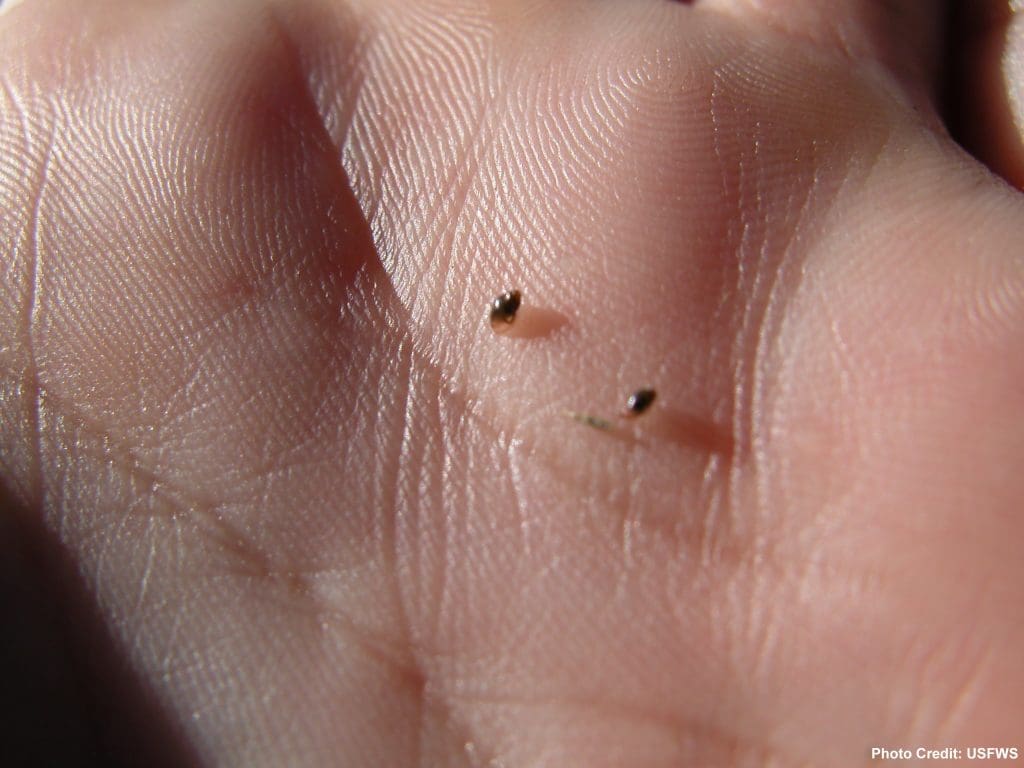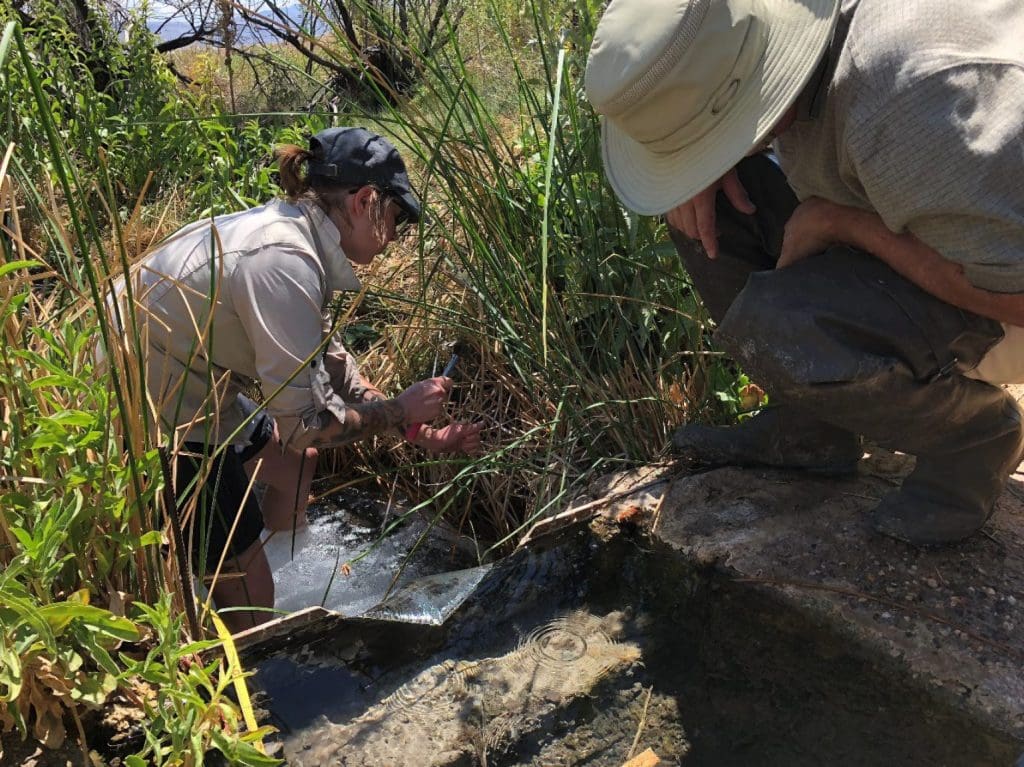
Exotic Fish Pose a Threat to Native Springsnails at Blue Point Spring

In the Mojave Desert, the driest and smallest desert in the United States, permanent sources of water are few and far between. Where water does exist, it is an essential resource for flora and fauna of all shapes and sizes.
“Really nothing in the desert can survive without water,” said Chenoa Wilcox, an ecologist and educator at the University of Nevada Las Vegas (UNLV). “So, preserving what water sources we have is just absolutely critical.”
Land managers and scientists work to maintain desert water sources using a variety of strategies, but they are up against a growing number of anthropogenic threats. In the waters of the West, the dumping of exotic fish has proven to be a particularly devastating problem.
An Ancient Oasis
A few years ago, associate professor Dr. Jef Jaeger from UNLV and representatives from the US Fish and Wildlife Service, the National Park Service, and the Nevada Department of Wildlife began discussing a plan to remove exotic fish from Blue Point Spring, a naturally occurring, groundwater-dependent spring located on National Park Service lands within the Lake Mead National Recreation Area.
Records show the spring has been a part of the landscape since the Pleistocene—and it still flows today. Over the years, however, people have dumped exotic fish into the water. At one point in the 1950s, Blue Point Spring was even used by traders to raise tropical aquarium fish. Some of these nonnative fish have proven to be a problem for the spring’s native species, whether through competition or predation.
As the managers and scientists discussed the pros and cons of removing the invaders from the spring, conversation shifted to a tiny species the size of the tip of a ballpoint pen: Pyrgulopsis coloradensis.

Pyrgulopsis coloradensis is an aquatic springsnail found only at Blue Point Spring. Although it is small, researchers think it might play an important role in the ecosystem because of its typically large population size.
The group was concerned about the impact that management decisions might have on the snail, and there was uncertainty surrounding even the size of the springsnail population. In several previous surveys, scientists had been unable to detect the springsnails, whereas in other surveys the snails were abundant. This led to talk of a new study—one that might provide conclusive evidence concerning the abundance of the springsnail.
The Springsnail Study
In 2018, Western National Parks Association provided Jaegar funding to do a baseline study on the springsnail species, which Wilcox took on as her master’s project. Jaegar and Wilcox collaboratively designed methods to evaluate the springsnail’s seasonal distribution, relative abundance, and habitat associations.
Over the course of a year, Wilcox and a team of undergraduates implemented the methods, both in the field at Blue Point Spring and in the lab. The researchers included another endemic springsnail species in their work—Tryonia infernalis—given the overlapping prevalence of the two snail species.
At Blue Point Spring, Wilcox used several sampling strategies to evaluate the springsnail populations over eight-week intervals from August 2018 to September 2019. The study site, which was about 20 meters long, was separated into two separate pools by a weir—a structure that acts as both a dam and a gauging station to monitor the spring’s flow rate.
Above the weir, in the source pool, there are typically no fish present, because of efforts to eradicate nonnative fish. Below the weir, exotic fish including convict cichlids, short-finned mollies, and mosquitofish have established viable populations. Near the end of the study, the researchers evaluated how fish predation in the lower pool had affected springsnails.

The Findings
After a year of research, Wilcox and her team found that, above the weir, populations of both P. coloradensis and T. infernalis were genetically diverse and reasonably robust, with thousands of the springsnails present. Below the weir, however, very few individuals of either species were found.
The researchers also found that convict cichlids have a detrimental impact on the springsnails. During a 10-minute feeding alone, one convict cichlid fish consumed more than 200 springsnails. Based on this information, the researchers determined that maintaining the integrity of the weir would be extremely important for maintaining the springsnail populations in the years to come.
“When you’re releasing into these riparian areas, this new organism can have completely unknown consequences on the native species that are there,” Wilcox said. “Releasing your fish into this nice, cozy thermal spring habitat—it probably is a good life for some fish, but it’s not going to be a good life for numerous native organisms.”
An Uncertain Future
Wilcox’s findings will help inform land managers about best practices in managing the spring and protecting the springsnails in the future. Although the research found that both P. coloradensis and T. infernalis were abundant in the system above the weir, both Wilcox and Jaeger pointed out that these tiny creatures are still of conservation concern.
“It gets more complicated once you consider the fact that these snails don’t exist anywhere else in the world,” Wilcox said. “My research doesn’t take into account the possibility of someone or something coming along and destroying any part of their habitat. By manipulating a single site, you could wipe out this entire species.”
Ironically, shortly after Wilcox wrapped up her research, someone used lumber and pipes to construct a structure that caused the lower pool to flood. This connected the source pool with the lower pool, and nonnative fish were able to enter the source pool. Because of Wilcox’s findings, biologists were keenly aware of the negative impact exotic fish can have on the springsnails. They quickly disassembled the harmful construction and eradicated fish from the source pool.
Wilcox and Jaeger concluded that more research should be done on the springsnails to gain an even better understanding of their population dynamics and function in the tiny ecosystem. It will be critical for the springsnails—and for Blue Point Spring itself—to keep the weir in place and invasive fish at bay.
“The people of the United States, through their representatives back during Nixon time . . . argued that maintaining species and maintaining ecosystems is important, and we have stringent laws about that,” Jaeger said. “Pyrgulopsis is not an endangered species, but they all could be. And so, if they become an endangered species, then the legislation is pretty heavy-handed. I think being good stewards requires us to manage things before they get to that point—before they’re at a point of becoming extinct.”
By Madison Beal, journalism graduate student at the University of Arizona
Since 1938 WNPA has funded scientific research to help advance the management, preservation, and interpretation of our national parks. WNPA has partnered with the University of Arizona School of Journalism to provide engaging stories about the research projects completed with the aid of WNPA funding. Your American West will feature one of these stories in each of the next few issues. Discover more of the historical, social, and environmental research projects WNPA has funded in recent years on our website.



